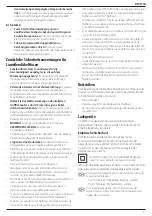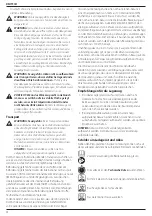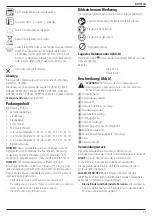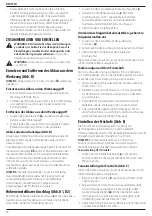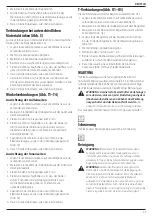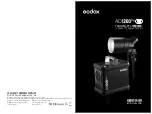
34
EngLIsh
Chargers
D
e
WALT
chargers require no adjustment and are designed to be
as easy as possible to operate.
Electrical Safety
The electric motor has been designed for one voltage only.
Always check that the battery pack voltage corresponds to the
voltage on the rating plate. Also make sure that the voltage of
your charger corresponds to that of your mains.
i
Your
D
e
WALT
charger is double insulated in accordance
with EN60335; therefore no earth wire is required.
If the supply cord is damaged, it must be replaced only by
D
e
WALT
or an authorised service organisation.
Mains Plug Replacement
(U.K. & Ireland Only)
If a new mains plug needs to be fitted:
• Safely dispose of the old plug.
• Connect the brown lead to the live terminal in the plug.
• Connect the blue lead to the neutral terminal.
WARNING:
No connection is to be made to the
earth terminal.
Follow the fitting instructions supplied with good quality plugs.
Recommended fuse: 3 A.
Using an Extension Cable
An extension cord should not be used unless absolutely
necessary. Use an approved extension cable suitable for the
power input of your charger (see
Technical Data
). The minimum
conductor size is 1 mm
2
; the maximum length is 30 m.
When using a cable reel, always unwind the cable completely.
Important Safety Instructions for All Battery Chargers
SAVE THESE INSTRUCTIONS:
This manual contains important
safety and operating instructions for compatible battery
chargers (refer to
Technical Data
).
• Before using charger, read all instructions and cautionary markings
on charger, battery pack, and product using battery pack.
WARNING:
Shock hazard. Do not allow any liquid to get
inside charger. Electric shock may result.
WARNING:
We recommend the use of a residual current
device with a residual current rating of 30mA or less.
CAUTION:
Burn hazard. To reduce the risk of injury,
charge only
D
e
WALT
rechargeable batteries. Other types of
batteries may burst causing personal injury and damage.
CAUTION:
Children should be supervised to ensure that
they do not play with the appliance.
Residual Risks
In spite of the application of the relevant safety regulations
and the implementation of safety devices, certain residual risks
cannot be avoided. These are:
• Impairment of hearing.
• Risk of injury when changing the disc.
• Risk of dust inhalation from materials that when cut, can
be harmful.
Additional Specific Safety Rules for the
Biscuit Jointer
•
Disc cutters must be rated for at least the speed marked
on the tool.
Disc cutters running over rated speed can fly
apart and cause injury.
•
Always use the guard.
The guard protects the operator from
broken disc cutter fragments and unintentional contact with
the disc cutter.
•
Hold the power tool by insulated gripping surfaces,
when performing an operation where the cutting
accessory may contact hidden wiring.
Cutting accessory
contacting a "live" wire may make exposed metal parts of the
power tool "live" and could give the operator an electric shock
.
•
MAXIMUM
allowed disc cutter diameter is 102 mm.
•
DO NOT
use blunt or damaged disc cutters.
• Check the proper function of the guard retracting system
before use.
•
Wear a dust mask.
Exposure to dust particles can cause
breathing difficulty and possible injury.
• Always ensure that the power tool is switched off before
plugging into the mains.
• Do not switch off before the blade is running freely.
• Remove all nails and metal objects from the workpiece before
starting work.
• After switching off, never attempt to stop the blade by pressing
against the side of the blade.
• The tool must only be used for cutting wood or plastic.
• Ensure that all devices screening the blade are in perfect
working order.
• Never put the tool down on a table or workbench unless
switched off.
• Only blades conforming to the specifications contained in
these operating instructions may be used.
• Blades made of high alloy, high-speed steel (HSS steel) should
not be used. Best results are achieved using carbide-tipped or
CrV blades.
• Only sharp blades in perfect working order should be used;
cracked or bent blades should be discarded and replaced
at once.
• Ensure that the blade is securely fixed and rotates in the
correct direction.
• Kickback occurs when the tool begins to stall rapidly and
is driven back towards the operator. Release the switch
immediately if the blade sticks or the tool stalls.
• Keep the blades sharp.
• Support large panels near the cutting area.
• Do not remove the tool from the workpiece while making a cut
with the blade rotating. Release the on/off switch and wait for
the blade to come to a halt.
Содержание XR DCW682
Страница 1: ...DCW682 ...
Страница 3: ...1 Fig A 3 4 5 8 7 11 1 6 9 12 13 2 Fig B 12 14 12 13 XXXX XX XX 20 10 13 ...
Страница 4: ...2 Fig C Fig D1 Fig D2 Fig E Fig F Fig G Fig H Fig I 1 11 8 6 6 9 4 2 15 7 23 ...
Страница 6: ...4 5 7 5 cm 15 25 cm 15 25 cm Fig N3 Fig N4 Fig O Fig P1 Fig P2 Fig Q1 Fig Q2 Fig Q3 ...
Страница 7: ...5 Fig R1 Fig R2 Fig S Fig T1 Fig T4 Fig U1 Fig T2 Fig T3 ...
Страница 8: ...6 Fig U2 Fig U3 Fig U4 Fig U5 Fig V 3 19 ...
Страница 163: ......


